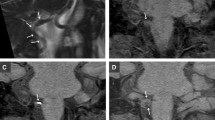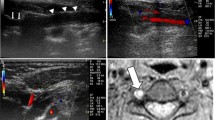Abstract
Introduction
This study aims to demonstrate the added value of a 3D fat-saturated (FS) T1 sampling perfection with application-optimised contrast using different flip angle evolutions (SPACE) sequence compared to 2D FS T1 spin echo (SE) for the diagnosis of cervical artery dissection.
Methods
Thirty-one patients were prospectively evaluated on a 1.5-T MR system for a clinical suspicion of acute or subacute cervical artery dissection with 3D T1 SPACE sequence. In 23 cases, the axial 2D FS T1 SE sequence was also used; only these cases were subsequently analysed. Two neuroradiologists independently and blindly assessed the 2D and 3D T1 sequences. The presence of recent dissection (defined as a T1 hyperintensity in the vessel wall) and the quality of fat suppression were assessed. The final diagnosis was established in consensus, after reviewing all the imaging and clinical data.
Results
Overall sensitivity and specificity were 0.929 and 1 for axial T1 SE, and 0.965 and 0.945 for T1 SPACE (P > 0.05), respectively. The two readers had excellent agreement for both sequences (k = 1 and 0.8175 for T1 SE and T1 SPACE, respectively; P > 0.05). The quality of the fat saturation was similar. Very good fat saturation was obtained in the upper neck. Multiplanar reconstructions were very useful in tortuous regions, such as the atlas loop of the vertebral artery or the carotid petrous entry. 3D T1 SPACE sequence has a shorter acquisition time (3 min 25 s versus 5 min 32 s for one T1 SE sequence) and a larger coverage area.
Conclusion
3D T1 SPACE sequence offers similar information with its 2D counterpart, in a shorter acquisition time and larger coverage area.






Similar content being viewed by others
References
Ducrocq X, Lacour JC, Debouverie M, Bracard S, Girard F, Weber M (1999) Cerebral ischemic accidents in young subjects. A prospective study of 296 patients aged 16 to 45 years. Rev Neurol (Paris) 155(8):575–582
Zach V, Zhovtis S, Kirchoff-Torres KF, Weinberger JM (2012) Common carotid artery dissection: a case report and review of the literature. J Stroke Cerebrovasc Dis 21(1):52–60
Vertinsky AT, Schwartz NE, Fischbein NJ, Rosenberg J, Albers GW, Zaharchuk G (2008) Comparison of multidetector CT angiography and MR imaging of cervical artery dissection. AJNR Am J Neuroradiol 29(9):1753–1760
Brugieres P, Castrec-Carpo A, Heran F, Goujon C, Gaston A, Marsault C (1989) Magnetic resonance imaging in the exploration of dissection of the internal carotid artery. J Neuroradiol 16(1):1–10
Goldberg HI, Grossman RI, Gomori JM, Asbury AK, Bilaniuk LT, Zimmerman RA (1986) Cervical internal carotid artery dissecting hemorrhage: diagnosis using MR. Radiology 158(1):157–161
Rothrock JF, Lim V, Press G, Gosink B (1989) Serial magnetic resonance and carotid duplex examinations in the management of carotid dissection. Neurology 39(5):686–692
Naggara O, Louillet F, Touze E, Roy D, Leclerc X, Mas JL, Pruvo JP, Meder JF, Oppenheim C (2010) Added value of high-resolution MR imaging in the diagnosis of vertebral artery dissection. AJNR Am J Neuroradiol 31(9):1707–1712
Flis CM, Jager HR, Sidhu PS (2007) Carotid and vertebral artery dissections: clinical aspects, imaging features and endovascular treatment. Eur Radiol 17(3):820–834
Anzalone N, Cadioli M (2011) Vertebral artery dissection: looking for the ideal study protocol. AJNR Am J Neuroradiol 32(5):E91, author reply E92
Bachmann R, Nassenstein I, Kooijman H, Dittrich R, Kugel H, Niederstadt T, Kuhlenbaumer G, Ringelstein EB, Kramer S, Heindel W (2006) Spontaneous acute dissection of the internal carotid artery: high-resolution magnetic resonance imaging at 3.0 tesla with a dedicated surface coil. Investig Radiol 41(2):105–111
Ozdoba C, Sturzenegger M, Schroth G (1996) Internal carotid artery dissection: MR imaging features and clinical-radiologic correlation. Radiology 199(1):191–198
Stanisz GJ, Odrobina EE, Pun J, Escaravage M, Graham SJ, Bronskill MJ, Henkelman RM (2005) T1, T2 relaxation and magnetization transfer in tissue at 3T. Magn Reson Med 54(3):507–512
Busse RF, Brau AC, Vu A, Michelich CR, Bayram E, Kijowski R, Reeder SB, Rowley HA (2008) Effects of refocusing flip angle modulation and view ordering in 3D fast spin echo. Magn Reson Med 60(3):640–649
Bernstein MA, Fain SB, Riederer SJ (2001) Effect of windowing and zero-filled reconstruction of MRI data on spatial resolution and acquisition strategy. J Magn Reson Imaging 14(3):270–280
Landis JR, Koch GG (1977) The measurement of observer agreement for categorical data. Biometrics 33(1):159–174
Schievink WI (2001) Spontaneous dissection of the carotid and vertebral arteries. N Engl J Med 344(12):898–906
Habs M, Pfefferkorn T, Cyran CC, Grimm J, Rominger A, Hacker M, Opherk C, Reiser MF, Nikolaou K, Saam T (2011) Age determination of vessel wall hematoma in spontaneous cervical artery dissection: a multi-sequence 3T cardiovascular magnetic resonance study. J Cardiovasc Magn Reson 13:76
Cha JG, Jin W, Lee MH, Kim DH, Park JS, Shin WH, Yi BH (2011) Reducing metallic artifacts in postoperative spinal imaging: usefulness of IDEAL contrast-enhanced T1- and T2-weighted MR imaging—phantom and clinical studies. Radiology 259(3):885–893
Edjlali M, Roca P, Rabrait C, Naggara O, Oppenheim C (2012) 3D fast spin-echo T1 black-blood imaging for the diagnosis of cervical artery dissection. AJNR Am J Neuroradiol. doi: 10.3174/ajnr.A3261
Acknowledgments
We thank Dominik Paul from Siemens Healthcare for his valuable support on the 3D FS T1 SPACE prototype sequence.
Conflict of interest
We declare that we have no conflict of interest.
Author information
Authors and Affiliations
Corresponding author
Rights and permissions
About this article
Cite this article
Cuvinciuc, V., Viallon, M., Momjian-Mayor, I. et al. 3D fat-saturated T1 SPACE sequence for the diagnosis of cervical artery dissection. Neuroradiology 55, 595–602 (2013). https://doi.org/10.1007/s00234-013-1141-1
Received:
Accepted:
Published:
Issue Date:
DOI: https://doi.org/10.1007/s00234-013-1141-1




